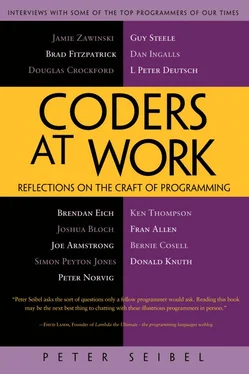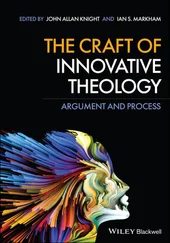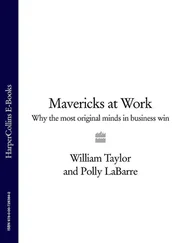Peter Seibel - Coders at Work - Reflections on the craft of programming
Здесь есть возможность читать онлайн «Peter Seibel - Coders at Work - Reflections on the craft of programming» весь текст электронной книги совершенно бесплатно (целиком полную версию без сокращений). В некоторых случаях можно слушать аудио, скачать через торрент в формате fb2 и присутствует краткое содержание. Жанр: Программирование, на английском языке. Описание произведения, (предисловие) а так же отзывы посетителей доступны на портале библиотеки ЛибКат.
- Название:Coders at Work: Reflections on the craft of programming
- Автор:
- Жанр:
- Год:неизвестен
- ISBN:нет данных
- Рейтинг книги:3 / 5. Голосов: 1
-
Избранное:Добавить в избранное
- Отзывы:
-
Ваша оценка:
- 60
- 1
- 2
- 3
- 4
- 5
Coders at Work: Reflections on the craft of programming: краткое содержание, описание и аннотация
Предлагаем к чтению аннотацию, описание, краткое содержание или предисловие (зависит от того, что написал сам автор книги «Coders at Work: Reflections on the craft of programming»). Если вы не нашли необходимую информацию о книге — напишите в комментариях, мы постараемся отыскать её.
Coders at Work
Founders at Work
Coders at Work: Reflections on the craft of programming — читать онлайн бесплатно полную книгу (весь текст) целиком
Ниже представлен текст книги, разбитый по страницам. Система сохранения места последней прочитанной страницы, позволяет с удобством читать онлайн бесплатно книгу «Coders at Work: Reflections on the craft of programming», без необходимости каждый раз заново искать на чём Вы остановились. Поставьте закладку, и сможете в любой момент перейти на страницу, на которой закончили чтение.
Интервал:
Закладка:
After having gone through four different architectures I wound up with an architecture for the rendering side of the program—which I think is by far the hardest part—based on equational programming. You define variable values in terms of equations then you let the implementation decide when to evaluate them. Turns out that’s not too hard to do in Python. It’s been done at least two other times that I know of. I like the way I do it because it has the least boilerplate.
So yeah, so I still do a moderate amount of programming and I still have fun with it. But it’s not for anybody and if I don’t do programming for weeks at a time, that’s OK. When that was what I did professionally, I always wanted to be in the middle of a project. Now, what I want to always be in the middle of is at least one or two compositions.
Seibel:You said before that you thought you could make the world a better place with software. How did you think that was going to happen?
Deutsch:Part of it had nothing to do with software per se; it’s just that seeing anything around me that’s being done badly has always offended me mightily, so I thought I could do better. That’s the way kids think. It all seems rather dreamlike now.
Certainly at the time that I started programming, and even up into the 1980s, computer technology was really associated with the corporate world. And my personal politics were quite anticorporate. The kind of computing that I’ve always worked on has been what today we would call personal computing, interactive computing. I think part of my motivation was the thought that if you could get computer power into the hands of a lot of people, that it might provide some counterweight to corporate power.
I never in my wildest dreams would have predicted the evolution of the Internet. And I never would’ve predicted the degree to which corporate influence over the Internet has changed its character over time. I would’ve thought that the Internet was inherently uncontrollable, and I no longer think that. China shows that you can do it pretty effectively.
And I think there’s a good chance that if Microsoft plays its cards right, they will have a lock on the Internet. I’m sure they would love to, but I think they might be smart enough to see the path from where they are to having what effectively is control of essentially all the software that gets used on the Internet.
So I’m not really much of an optimist about the future of computing. To be perfectly honest, that’s one of the reasons why it wasn’t hard for me to get out. I mean, I saw a world that was completely dominated by an unethical monopolist, and I didn’t see much of a place for me in it.
Ken Thompson
Ken Thompson is the original bearded Unix hacker. He has spent a career working on whatever he finds interesting, which has, at various times, included analog computing, systems programming, regular expressions, and computer chess.
Hired as a researcher at Bell Labs to work on the MULTICS project, after Bell Labs pulled out of MULTICS, Thompson went on, with Dennis Ritchie, to invent Unix, an endeavor for which he fully expected to be fired. He also invented the B programming language, the precursor to Dennis Ritchie’s C.
Later he got interested in computer chess, building Belle, the first special-purpose chess computer and the strongest computerized chess player of its time. He also helped expand chess endgame tablebases to cover all four- and five-piece endgames.
When working on Bell Labs’ Plan 9 operating system, he devised the now ubiquitous UTF-8 Unicode encoding.
In 1983, Thompson and Ritchie received the Turing Award for their “development of generic operating systems theory and specifically for the implementation of the Unix operating system.” He was also awarded the National Medal of Technology and the Institute of Electrical and Electronics Engineers Tsutomu Kanai Award, both for his work on Unix.
In this interview he talked about his early love of electronics, a rather unorthodox academic career that had him teaching courses while he was still a student, and why modern programming scares him.
Seibel:How did you learn to program?
Thompson:I was always fascinated with logic and even in grade school I’d work on arithmetic problems in binary, stuff like that. Just because I was fascinated.
Seibel:Did you turn them in that way?
Thompson:No, no. But I worked out the algorithms for adding in different bases, what carry means, and what each column means and things like that. Then I had a little calculator, a decimal calculator. It was like a decimal abacus. Instead of one and two it had a slide from zero to nine. It had a subtract one from a previous column down and an add one from the previous column up. So you’d put a stylus in, like a four, and run it up and hook over if you want to carry. And I built some binary stuff based on that and how that generalized to n -ary.
Seibel:Where did you even get that notion of binary arithmetic?
Thompson:In the class at the time I actually started doing this, they introduced binary.
Seibel:Were you a victim of the “new math?”
Thompson:No, no. I was victim of bad math. I moved every year or so and I was in some really, really horrible schools and then some good schools. So I would have to do two years of work in one year and then I’d be off a year. I was just loafing through math, so I had a horrible math primary education. And this one class they just described binary arithmetic. I took that and extended it to any base and played with that. So that’s kind of where I got started.
Seibel:And that was in grade school?
Thompson:Yeah, seventh grade. Then around senior year in high school, somewhere around in that time, I was into electronics a lot, building radios and amplifiers and oscillators and theremins. And I got hooked on analog computing. It was really marvelous. Electronics was my passion during all that time. I went into double E at Berkeley, and there I saw real digital computers for the first time in my junior year.
Seibel:And so what year would that have been?
Thompson:I went to junior semester early, so it was three semesters in. I started school in September ’60, so it would be the fall or spring of ’62. They had an analog computer which I had a great time with. And they had a G15, a drum computer. They had one lab class on it and then it was open. Anybody could play with it, but no one did, so it was free. And I used it essentially exclusively. I wrote programs on it, on my own, to scale an analog computer—analog computing is almost all scaling.
Seibel:Scaling in the sense of?
Thompson:Time scaling and amplitude scaling. Basically what you do is you build it to do a function. You put some input in and then you get a function of that input out and you concatenate these things with feedback. And at every point in this process you can’t go too high or you’ll clip.
Likewise there’s time scaling—you halve the frequency at different places or double the frequency in different places. And when you do that, a bunch of the linear scaling changes also. So if you have a simple job that doesn’t need scaling, analog is really great. But as soon as you need scaling it becomes very, very complex. And so I wrote digital computer programs to scale the analog computer setups. Without computing the actual wave forms, you compute the amplitude and frequency of the wave form at every point. And then it tells you when you’re out of range for whatever operation you’re doing at that time.
Читать дальшеИнтервал:
Закладка:
Похожие книги на «Coders at Work: Reflections on the craft of programming»
Представляем Вашему вниманию похожие книги на «Coders at Work: Reflections on the craft of programming» списком для выбора. Мы отобрали схожую по названию и смыслу литературу в надежде предоставить читателям больше вариантов отыскать новые, интересные, ещё непрочитанные произведения.
Обсуждение, отзывы о книге «Coders at Work: Reflections on the craft of programming» и просто собственные мнения читателей. Оставьте ваши комментарии, напишите, что Вы думаете о произведении, его смысле или главных героях. Укажите что конкретно понравилось, а что нет, и почему Вы так считаете.












